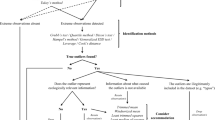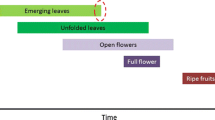Abstract
Citizen science involves public participation in research, usually through volunteer observation and reporting. Data collected by citizen scientists are a valuable resource in many fields of research that require long-term observations at large geographic scales. However, such data may be perceived as less accurate than those collected by trained professionals. Here, we analyze the quality of data from a plant phenology network, which tracks biological response to climate change. We apply five algorithms designed to detect outlier observations or inconsistent observers. These methods rely on different quantitative approaches, including residuals of linear models, correlations among observers, deviations from multivariate clusters, and percentile-based outlier removal. We evaluated these methods by comparing the resulting cleaned datasets in terms of time series means, spatial data coverage, and spatial autocorrelations after outlier removal. Spatial autocorrelations were used to determine the efficacy of outlier removal, as they are expected to increase if outliers and inconsistent observations are successfully removed. All data cleaning methods resulted in better Moran’s I autocorrelation statistics, with percentile-based outlier removal and the clustering method showing the greatest improvement. Methods based on residual analysis of linear models had the strongest impact on the final bloom time mean estimates, but were among the weakest based on autocorrelation analysis. Removing entire sets of observations from potentially unreliable observers proved least effective. In conclusion, percentile-based outlier removal emerges as a simple and effective method to improve reliability of citizen science phenology observations.




Similar content being viewed by others
References
Aggarwal CC (2013) Outlier analysis. Springer, New York
Beaubien E, Freeland HJ (2000) Spring phenology trends in Alberta, Canada: links to ocean temperature. Int J Biometeorol 44:53–59
Beaubien E, Hamann A (2011a) Spring flowering response to climate change between 1936 and 2006 in Alberta, Canada. Biosci 61:514–524. https://doi.org/10.1525/bio.2011.61.7.6
Beaubien E, Hamann A (2011b) Plant phenology network of citizen scientists: recommendations from two decades of experience in Canada. Int J Biometeorol 55:833–841. https://doi.org/10.1007/s00484-011-0457-y
Beaubien E, Johnson DL (1994) Flowering plant phenology and weather in Alberta, Canada. Int J Biometeorol 38:23–27
Bonney R, Cooper CB, Dickinson J, Kelling S, Phillips T, Rosenberg KV, Shirk J (2009) Citizen science: a developing tool for expanding science knowledge and scientific literacy. Bioscience 59:977–984
Butler DG, Cullis BR, Gilmour AR, Gogel BJ (2009) ASReml-R reference manual version 3. www.vsni.co.uk
Crall AW, Newman GJ, Stohlgren TJ, Holfelder KA, Graham J, Waller DM (2011) Assessing citizen science data quality: an invasive species case study. Conserv Lett 4:433–442. https://doi.org/10.1111/j.1755-263X.2011.00196.x
Crall AW, Jarnevich CS, Young NE, Panke BJ, Renz M, Stohlgren TJ (2015) Citizen science contributes to our knowledge of invasive plant distributions. Biol Invasions 17:2415–2427. https://doi.org/10.1007/s10530-015-0885-4
Danielsen F, Jensen PM, Burgess ND, Altamirano R, Alviola PA, Andrianandrasana H, Brashares JS, Burton AC, Coronado I, Corpuz N, Enghoff M, Fjeldså J, Funder M, Holt S, Hübertz H, Jensen AE, Lewis R, Massao J, Mendoza MM, Ngaga Y, Pipper CB, Poulsen MK, Rueda RM, Sam MK, Skielboe T, Sørensen M, Young R (2014) A multicountry assessment of tropical resource monitoring by local communities. Bioscience 64:236–251. https://doi.org/10.1093/biosci/biu001
DataONE (2017) DataONE education module: data quality control and assurance. Data Observation network for Earth. https://www.dataone.org/sites/all/documents/education-modules/pptx/L05_DataQualityControlAssurance.pptx. Accessed 1 Nov 2017
Dickinson JL, Shirk J, Bonter D, Bonney R, Crain RL, Martin J, Phillips T, Purcell K (2012) The current state of citizen science as a tool for ecological research and public engagement. Front Ecol Environ 10:291–297
Donaldson J (2012) tsne: t-distributed stochastic neighbor embedding for R (t-SNE). R. Package version 0.1–2. http://CRAN.R-project.org/package=tsne
Donnelly A, Yu R (2017) The rise of phenology with climate change: an evaluation of IJB publications. Int J Biometeorol 61(Suppl 1):S29–S50. https://doi.org/10.1007/s00484-017-1371-8
Feldman RE, Zemaite I, Miller-Rushing AJ (2018) How training citizen scientists affects the accuracy and precision of phenological data. Int J Biometeorol 62:1421–1435
Foster-Smith J, Evans SM (2003) The value of marine ecological data collected by volunteers. Biol Conserv 113:199–213
Fraley C, Raftery AE, Murphy B, Scrucca L (2012) mclust version 4 for R: normal mixture modeling for model-based clustering, classification, and density estimation technical report no. 597. Department of Statistics, University of Washington
Fuccillo KK, Crimmins TM, de Riviera CE, Elder TS (2014) Assessing accuracy in science-based plant phenology monitoring. Int J Biometerol 59:917–926. https://doi.org/10.1007/s00484-014-0892-7
Gajer P, Schatz M, Salzberg SL (2004) Automated correction of genome sequence errors. Nuc Acids Res 32:562–569
Gueta T, Carmel Y (2016) Quantifying the value of user-level data cleaning for big data: a case study using mammal distribution models. Ecol Informat 34:139–145. https://doi.org/10.1016/j.ecoinf.2016.06.001
Havens K, Vitt P, Masi S (2012) Citizen science on a local scale: the Plants of Concern program. Front Ecol Environ 10:321–323. https://doi.org/10.1890/110258
Hufkens K (2017) khufkens/daymetr: download daymet data using R. Zenodo. https://doi.org/10.5281/zenodo.437886
Hunter J, Alabri A, van Ingen C (2013) Assessing the quality and trustworthiness of citizen science data. Concurrency Computat Pract Exper 25:454–466. https://doi.org/10.1002/cpe.2923
IPCC (2007) Intergovernmental Panel on Climate Change, Climate Change 2007: synthesis report. Contribution of Working Groups I, II, and III to the Fourth Assessment Report of the Intergovernmental Panel on Climate Change. Core Writing Team, Pachauri RK, Reisinger A (eds). IPCC, Geneva, Switzerland, 104 pp
Kosmala M, Wiggins A, Swanson A, Simmons B (2016) Assessing data quality in citizen science. Front Ecol Environ 14:551–560. https://doi.org/10.1002/fee.1436
MacKenzie CM, Murray G, Primack R, Weihrauch D (2017) Lessons from citizen science: assessing volunteer-collected plant phenology data with Mountain watch. Biol Conserv 208:121–126. https://doi.org/10.1016/j.biocon.2016.07.027
Mathew C, Güntsch A, Obst M, Vicario S, Haines R, Williams A, de Jong Y, Goble C (2014) A semi-automated workflow for biodiversity data retrieval, cleaning, and quality control. Biodivers Data J 2:e4221. https://doi.org/10.3897/BDJ.2.e4221
McKinley DC, Miller-Rushing AJ, Ballard HL et al (2017) Citizen science can improve conservation science, natural resource management, and environmental protection. Biol Conserv 208:15–28. https://doi.org/10.1016/j.biocon.2016.05.015
Mehdipoor H, Zurita-Milla R, Rosemartin A, Gerst KL, Weltzin JF (2015) Developing a workflow to identify inconsistencies in volunteered geographic information: a phenological case study Plos One 10. https://doi.org/10.1371/journal.pone.0140811
Miller-Rushing A, Primack R, Bonney R (2012) The history of public participation in ecological research. Front Ecol Environ 10:285–290. https://doi.org/10.1890/1102798
Moran PAP (1950) Notes on continuous stochastic phenomena. Biometrika. 37(1):17–23
Natural Regions Committee (2006) Natural regions and subregions of Alberta. Compiled by D.J. Downing and W.W. Pettapiece. Edmonton. Pub. No. T/852. Alberta Environment, Government of Alberta, Edmonton, AB
Paradis E, Claude J, Strimmer K (2004) APE: analysis of phylogenetics and evolution in R language. Bioinformatics 20:289–290
R Development Core Team (2018) R: a language and environment for statistical computing. R Foundation for Statistical Computing, Vienna http://www.R-project.org/
Ranjitkar S (2013) Effect of elevation and latitude on spring phenology of rhododendron and Kanchenjunga conservation area, East Nepal. Int J Appl Sci Biotech 1:253–257. https://doi.org/10.3126/ijasbt.v1i4.9154
Rathcke B, Lacey EP (1985) Phenological patterns of terrestrial plants. Ann Rev Ecol Syst 16:179–214
Schwartz MD, Beaubien EG, Crimmins TM, Weltzin JF (2013) Chapter 5. North America. In: Schwartz M (ed) Phenology: an integrative environmental science. Springer, Dortrecht, pp 67–89
Schwartz MD, Hanes JM, Liang L (2014) Separating temperature from other factors in phenological measurements. Int J Biometeorol 58:1699–1704. https://doi.org/10.1007/s00484-013-0723-2
Silvertown J (2009) A new dawn for citizen science. Trends Ecol Evol 24:467–471
Silvertown J, Buesching CD, Jacobson SK, Rebelo T (2013) Citizen science and nature conservation. In: Macdonald DW, Willis KJ (eds) Key topics in conservation biology 2, 1st edn. Wiley, New York, pp 127–142
Thornton PE, Thornton MM, Mayer BW, Wilhelmi N, Wei Y, Devarakonda R, Cook RB (2016) Daymet: daily surface weather data on a 1-km grid for North America, Version 3 ORNL DAAC, Oak Ridge, Tennessee, USA. Accessed June 5, 2017. Time period: 1987-01-01 to 2016-12-31. Spatial range: N=59.82, S=49.13, E=-109.22, W=-119.67. https://doi.org/10.3334/ORNLDAAC/1219
Tobler WR (1970) A computer movie simulating urban growth in the Detroit region. Econ Geogr 46:234–240. https://doi.org/10.2307/143141
USANPN (2017) USA National Phenology Network. How to observe. https://www.usanpn.org/nn/guidelines. Accessed 2 Nov 2017
van der Maaten L, Hinton G (2008) Visualizing data using t-SNE. J Mach Learn Res 9:1–48
Vander Stelt E, Fant JB, Masi S, Larkin DJ (2017) Assessing habitat requirements and genetic status of a rare ephemeral wetland plant species, Isoëtes butleri Engelm. Aquat Bot 138:74–81. https://doi.org/10.1016/j.aquabot.2017.01.002
Acknowledgments
We thank all citizen scientists that contributed to the Alberta PlantWatch program led by EB, and we appreciate their enthusiasm and continued support of this program.
Funding
Funding to carry out the analysis presented in this paper was provided by the NSERC Discovery Grant RGPIN-330527 to AH.
Author information
Authors and Affiliations
Corresponding author
Additional information
Publisher's note
Springer Nature remains neutral with regard to jurisdictional claims in published maps and institutional affiliations.
Rights and permissions
About this article
Cite this article
Li, J.S., Hamann, A. & Beaubien, E. Outlier detection methods to improve the quality of citizen science data. Int J Biometeorol 64, 1825–1833 (2020). https://doi.org/10.1007/s00484-020-01968-z
Received:
Revised:
Accepted:
Published:
Issue Date:
DOI: https://doi.org/10.1007/s00484-020-01968-z




